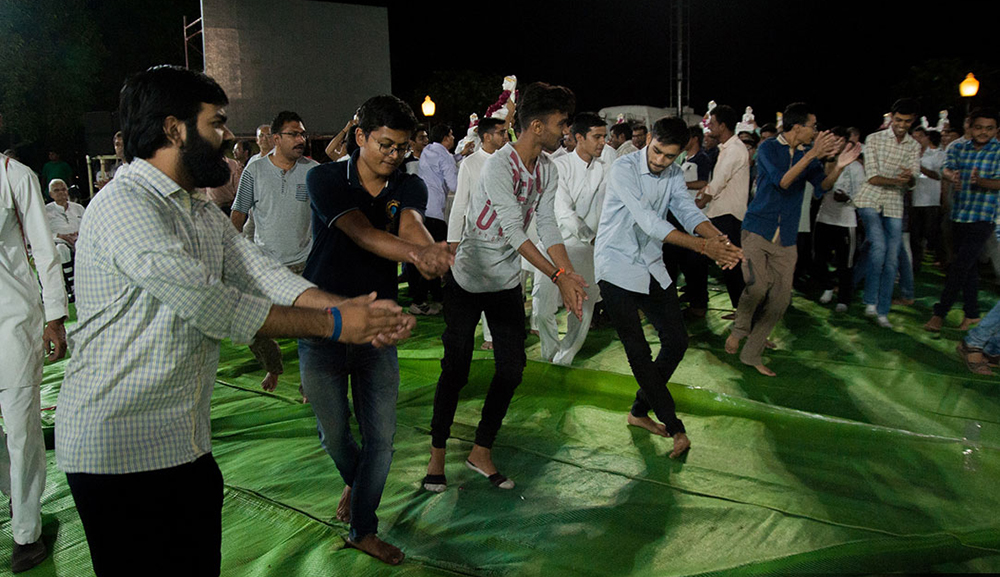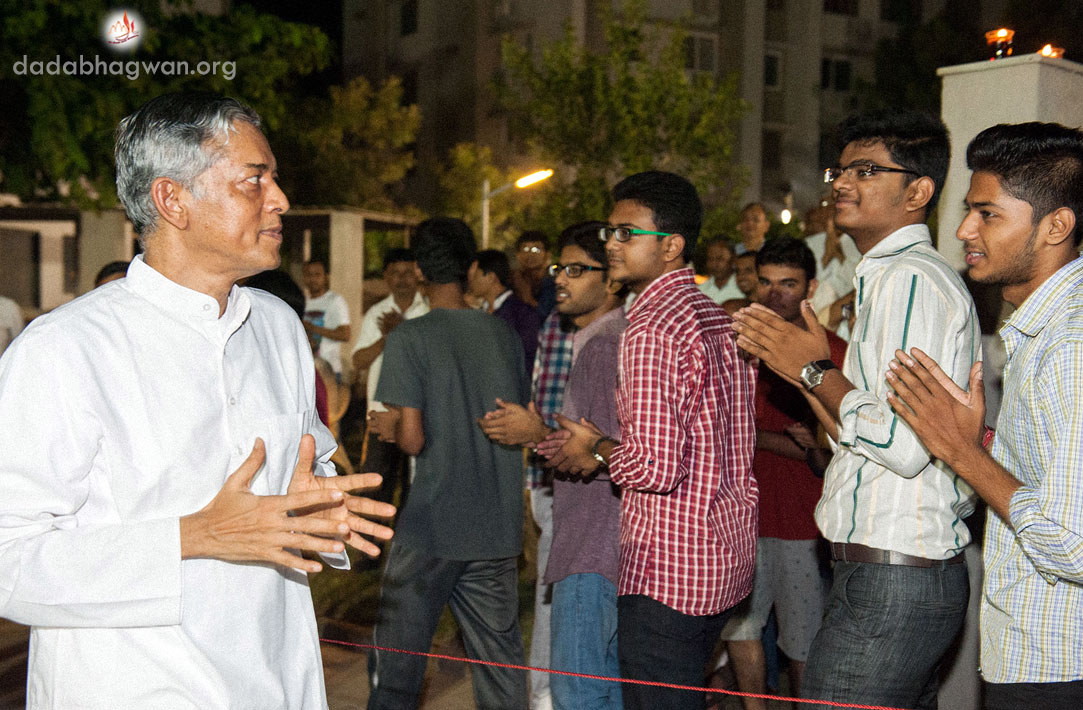You may or may not have heard of the term ‘Garba’, but for those of you who have, and have actually been to it, you must know the intense dancing, singing and clapping that’s associated! Having a beautiful history full of spiritual value, this Gujarat-originated dance has been slowly losing its core essence, becoming more of a fashion show and social gathering.

This definitely cannot be said for all Garba, but especially during the vastly significant nine day Hindu festival of Navratri, many forget the purpose behind why they are dancing around Ambe Maa (Goddess Amba), too caught up in the social aspect of this occasion. So let’s find out! How did Garba begin? What is the importance behind this dance? During which events may Garba be performed? To whom are your respects and prayers reaching while performing Garba? Along with all these questions, let’s take a look at Dada’s Garba! What are the benefits behind meaningfully performing Dada’s Garba? Why should you participate in Dada’s Garba at any opportunities that arise? Let’s try and delve into the purity and faith by which this fun tradition began!
Garba Mythology
Originating in the State of Gujarat, India, Garba is a joyful type of Indian dance that has a very deep historic beginning. Although performed in many occasions in Gujarat, as well as spreading throughout the nation and internationally, Garba is most common during the festival of Navratri. As the events from Hindu mythology portray, Mahishasura was a buffalo demon full of revenge and the intense desire to seek power. As the king of Asuras (demons), he set out to conquer the various worlds of heavens and hells.
Continuously bothered by Mahishasura’s approaches and under utmost despair, the Devs & Devis (celestial beings) set out to convey their hardships to Brahma (creator), Vishnu (preserver) and Shiva (destroyer), also known as the Hindu Trinity. Under the leadership of Indra Dev, they mentioned Mahishasura’s actions and together, the Trinity created the powerful ‘Durga’ (Amba) Goddess, known as the ‘Goddess of Shakti’ (strength). The beautiful Goddess is celebrated for Her divine victory of defeating Mahishasura, after a long, nine days. She defeated him on the tenth day of Vijayadashmi which also happens to be the very same day that Lord Ram defeated Ravana, Dashera. Thus, Nav (nine) Ratri (nights), consists of Garba celebrations depicting Amba Maa’s victory.
Performing Garba

This festive dance is performed during many Indian occasions and holidays such as Navratri, Holi, Vasant Panchami, Sharad Purnima, social events (weddings, baby showers) and spiritual events (Gurupurnima, satsang shibirs). Although Garba for Ambe Maa is widely known, there is a wide range of Garba, worshiping different Gods and Goddesses and sung by various singers in rhythms and paces. People stand in circular form and go around the circle following certain steps. They synchronize clapping their hands with the motion of their feet, often in a rather graceful and simultaneous motion. But what exactly are they dancing around? Well, the point of this circular dance is that people are circling around either a God / Goddess Murti (idol), picture, or lit lamp. The Garba songs are usually in regards to this idol, and thus, people are paying their respects with prayers and devotion to this Holiness. Beautiful colors are merged together from the array of Indian outfits and other décor. The most common music theme is starting with slow songs and moving to the faster, more upbeat songs!
Short Story: Gnani’s Viewpoint
Param Pujya Dadashri, always keen on relaying the Real perspective rather than the Worldly one that everyone is caught up in, was great at answering the ‘why?’ questions. On the topic of Garba, a Mahatma once asked Dadashri, “When is Garba to be done and why is it to be done?” To this question, Dada gave a brilliant response from the Gnan. He asked the Mahatma, “If you pick up that pot, will you be able to clap your hands?” The mahatma answered, “Not really, that will be difficult.” Dada then said, “So when are you able to clap your hands freely without any restrictions?” The mahatma replied, “Only when I have nothing in my hands will I be able to clap freely.” Dada then explained to the mahatma that this is the exact way to devote oneself to the Lord. When you have NOTHING in your hands, it signifies that you have given everything to the Lord.”
There are no items in this world (no money, no cars, and no people, nothing) that can match the happiness of the Pure Self. Thus, when you surrender everything you have to the Lord, that is when your hands are ‘FREE’ and you are ‘FREE’ to do the Lord’s true bhakti (devotional worship). Just like Dada has said, “Keval shuddhatma Anubhav sivay aa jagat ni koi pan vinashi chij mane joiti nathi” (Except for the experience of the pure Self, I do not want any temporary things of this world.) Dada explained that Garba is to be done in this manner as well. The clapping should be done with utmost sincerity and dedication such that you have given up everything you have to the Lord, and now, all you can give is your prayers and worship. When this intention is portrayed while doing Dada’s Garba, or any Garba for that matter, the merits or benefits you will receive will be astronomical. Unfortunately, during this time period, many are focused on the external matters, especially in regards to Garba. Thoughts such as, “I want to perform very nice Garba” and “I wish I meet my friends there” arise instead of realizing the main purpose of this beautiful tradition. When you are in complete oneness with the Lord and doing Garba only for the Lord, this is when the real fruits of your bhaav (intentions) will come through. It’s never too late to realize this and purify your intentions to attain the real Garba experience! Dada has even said that by genuinely doing Dada’s Garba, what in turn is Garba of your Pure Self within, it is equal to doing 50 Samayik (introspection for a specific time when one remains the Self and visualizes non-Self evidences or any errors committed like a movie)! Thus, if you think about it, just imagine how significant Garba is!
Why Should We Participate In Garba?
Param Pujya Dadashri, the Gnani Purush Himself, used to say that ‘Dada Bhagwan’ is not the A. M. Patel that everyone can see and talk to. ‘Dada Bhagwan’ is actually the enlightened soul within, which is the same for everyone. Dada Bhagwan is within every single living creature, whether visible or invisible, man or animal, small or big. There are infinite invisible creatures, which cannot be seen even under a microscope. God resides in all of them. Thus, as Dada said, “Every living being in this universe is the Lord of this universe.” In this very same aspect, He used to join and urge people to do Aarti and Garba around ‘Dada Bhagwan’ (the Lord within). When we do things like Aarti, vidhis and even Garba, we are actually praying and worshiping the Lord within, even though we cannot ‘SEE’ (with our naked eyes) this Lord. Thus during Garba, we also pay respects around other Gods and Goddesses (pictures / idols / divas), such as Simandhar Swami, Ambe Maa and even Pujya Dada Bhagwan, because we are asking for strength to become like them: ultimately Vitarag (the one who is free from attachment & abhorrence) so that we can also excel in the Moksh Marg (path of liberation). Overall, Garba is for our own Pure Selves and for what we want to become! We should partake in this auspicious tradition with the correct knowledge so that we directly get the immense benefits it projects. Also, believe it or not, the Gods and Goddesses that we are worshiping during things like Aarti and Garba, actually manifest at the very same place and occasion! So while you’re dancing, Dev / Devis are present as they are enjoying the music, prayers and pure Bhaavs everyone is sending their way. It’s fascinating how this science connects all the dots, isn't it? Well, the next time we’re too worried about how our Garba steps look, if we’re fashionable enough to go to Garba (how we look), if we’ll be meeting our friends at Garba, or even if we’re wondering during Satsang Shibirs whether to participate in Garba, let’s all just take a step back and remember the wonderful understanding of Garba and the amazing effects it will bring to us. With the purest of intentions, the upbeat rhythms, the enthusiastic people / Mahatmas, and the Lord / Gods / Goddesses, Garba is one experience you do not want to miss out on. The aim is not to ‘just do it’, but the aim is to ‘do it right (intentionally)!’
Plus, Garba Is Just Plain, Clean And Pure Fun!